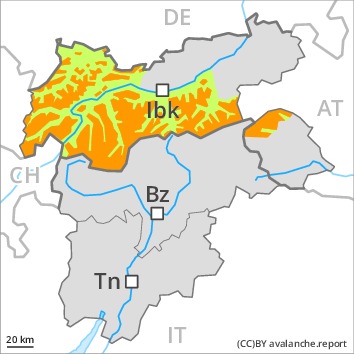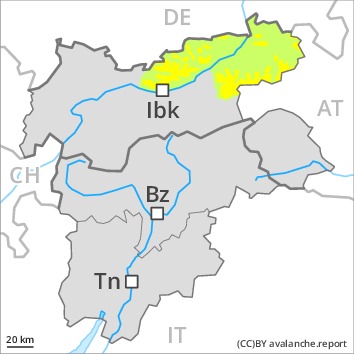
Danger level
 | treeline
|
Avalanche Problem
 | | Wind-drifted snow |
|  | |  |
 | | Persistent weak layer |
|  | |  |

Wind slabs and weakly bonded old snow require caution.
As a consequence of a sometimes strong wind from variable directions, easily released wind slabs formed. These can be released, even by a single winter sport participant and reach medium size. The avalanche prone locations are to be found in all aspects above the tree line. Avalanches can in isolated cases penetrate deep layers and reach large size.
Avalanches can be released in the weakly bonded old snow especially at transitions from a shallow to a deep snowpack, when entering gullies and bowls for example. This applies in particular above approximately 2000 m on steep west, north and east facing slopes. Between approximately 2000 and 2400 m the avalanche prone locations are more prevalent.
Snowpack
dp.6: cold, loose snow and wind
dp.7: snow-poor zones in snow-rich surrounding
The fresh and older wind slabs are lying on soft layers at high altitudes and in high Alpine regions.
Avalanche prone weak layers exist in the centre of the snowpack, especially between approximately 2000 and 2400 m on steep west, north and east facing slopes.
Tendency
Hardly any decrease in avalanche danger.

Danger level
 | treeline
|
Avalanche Problem

Fresh wind slabs represent the main danger.
As a consequence of a sometimes strong wind from variable directions, easily released wind slabs formed, especially adjacent to ridgelines and in gullies and bowls above the tree line. These can be released, even by a single winter sport participant and reach medium size. Avalanches can in isolated cases penetrate deep layers and reach large size.
A latent danger of gliding avalanches exists. Areas with glide cracks are to be avoided as far as possible.
Snowpack
dp.6: cold, loose snow and wind
The various wind slabs have bonded poorly together.
Faceted weak layers exist in the centre of the snowpack in particular above the tree line. This applies in all aspects.
Towards its base, the snowpack is moist and its surface has a melt-freeze crust, in particular at low and intermediate altitudes.
Tendency
Hardly any decrease in avalanche danger.

Danger level
 | 1800m
|
Avalanche Problem

Fresh wind slabs require caution.
As a consequence of a sometimes strong wind, avalanche prone wind slabs formed. The avalanche prone locations are to be found in particular adjacent to ridgelines. Such avalanche prone locations are clearly recognisable to the trained eye.
Weak layers in the old snowpack can still be released in very isolated cases by individual winter sport participants. This applies at high altitude, in particular in the Western Kitzbühel Alps.
Snowpack
dp.6: cold, loose snow and wind
In some cases the various wind slabs have bonded still only poorly together. Individual weak layers exist in the centre of the snowpack. At low altitude a little snow is lying.
Tendency
Hardly any decrease in avalanche danger.











